An interesting Premier League game was played on Saturday as Wolves took on Arsenal at the Molineux Stadium. Both teams were fighting for a continental competition ticket for next season, so Nuno Espírito Santo and Mikel Arteta had to try everything for three points.
Thanks to the goals from Bukayo Saka and Alexandre Lacazette, Arsenal’s European hope continued and we will delve into the tactics in this tactical analysis.
Lineups
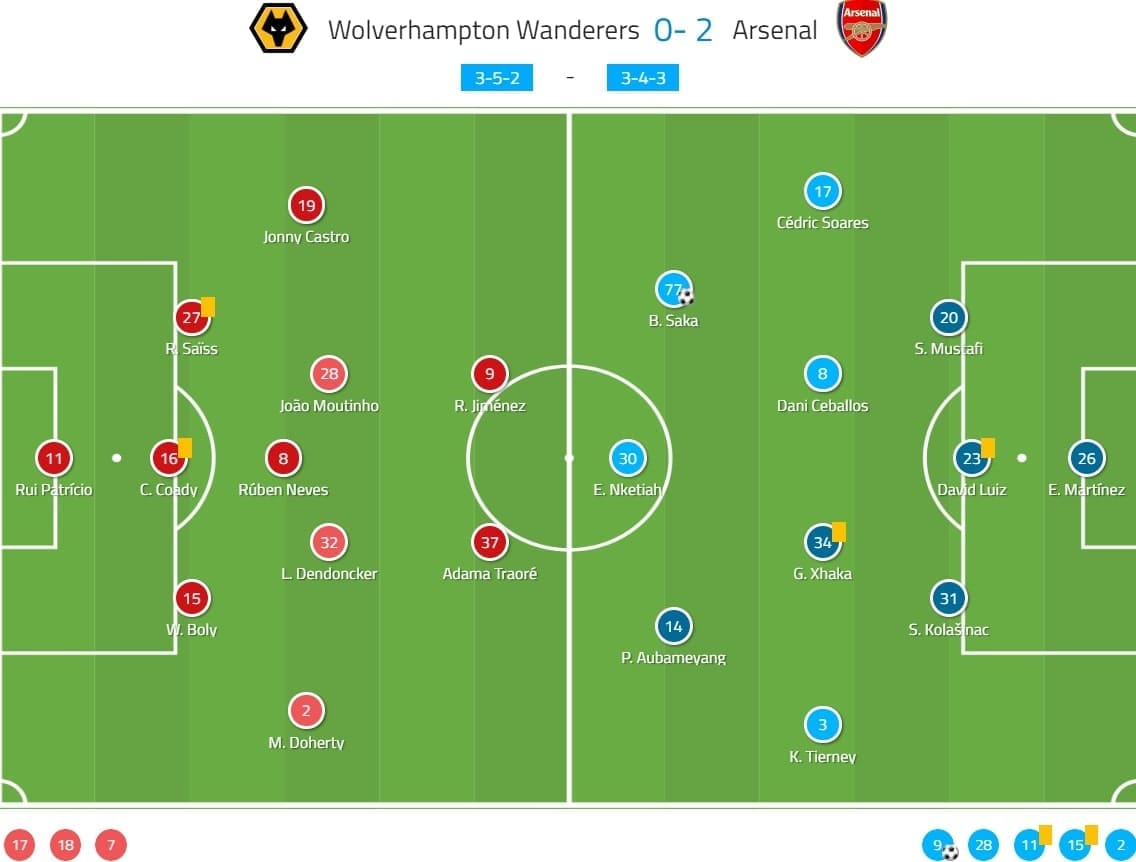
Wolves started their usual 3-5-2 formation, a relatively conservative shape compared with the 3-4-3 used in this season. Most key players were on the pitch, though it was unexpected to see Adama Traoré start, who partnered Raúl Jiménez as the strikers.
Arsenal played in a 3-4-3, with a pair of wing-backs that matched Wolves at the flanks. Cédric Soares had his first start for the Gunners. On the left, Sead Kolašinac was the left centre-back, having a good combination with Kieran Tierney the left wing-back. Mustafi and David Luiz were the two other centre-backs in the defence. Ahead of them were Dani Ceballos and Xhaka and the front three consisted of Aubameyang, Saka, and Nketiah.
Wolves: stubborn block
As expected, Wolves defended with their stubborn midblock. The defensive scheme could be roughly represented as a 5-5, which was formed by the back five and a pentagon shape at the central third.
The intention was clear – classic Nuno football that hoped to guide the ball wide, trap the attack at flanks, and recover possession by a numerical advantage. This block became a nightmare for teams playing out from the back, and this match was no exception.
Here, the pentagon shape is illustrated. It was incredibly compact at the centre of the pitch, and playing with a midfield three always overloaded the pair of Arsenal pivots. Also, the extra third layer was offered in this 3-5-2 shape when Rúben Neves dropped slightly deeper.
The Wolves midfielders were clear about their tasks, hence why they were shutting the central passing lanes initially. Here, João Moutinho covered the passing lane to Saka while leaving the wide player, Shkodran Mustafi, free. Even an experienced ball-playing centre-back like David Luiz was unable to penetrate through the block centrally.
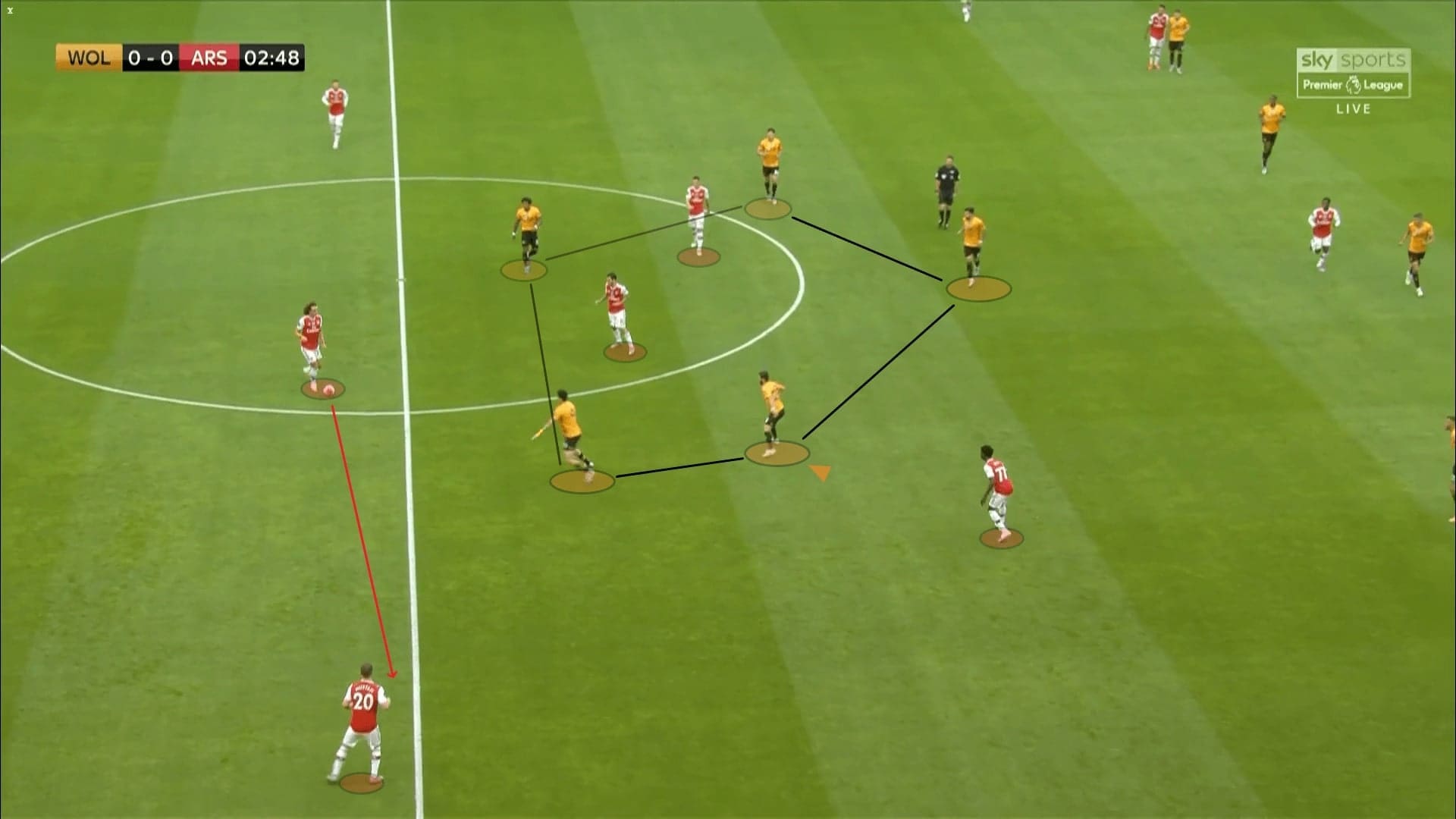
Guiding the ball to the flanks was only the first step. At the wide areas, the numerical advantage was guaranteed by committing two midfielders, ball-side centre-backs and wing-backs, or even a forward. A total of five players were overloading the outer regions and Arsenal were not matching with only three players at most.
Here was a typical example of the Wolves defence, the ball side was extremely crowded, and a 5 v 3 situation was created. The positioning of Conor Coady was vital to shut the in-ball route as it was accessible to Eddie Nketiah. Meanwhile, Wily Boly was tight on Pierre-Emerick Aubameyang. This mixed of zonal defence and the man-marking of the centre-backs had crammed the area. Without a clear progressive option, Arsenal circulated the ball to reorganise the attack.
Even though Arsenal tried to move the ball to the centre, Wolves could instantly pressure the receiver as the midfielders kept an accessible distance with the opponents. Throughout the game, Arteta’s men could not defeat this block and the defensive phase of Wolves were solid.
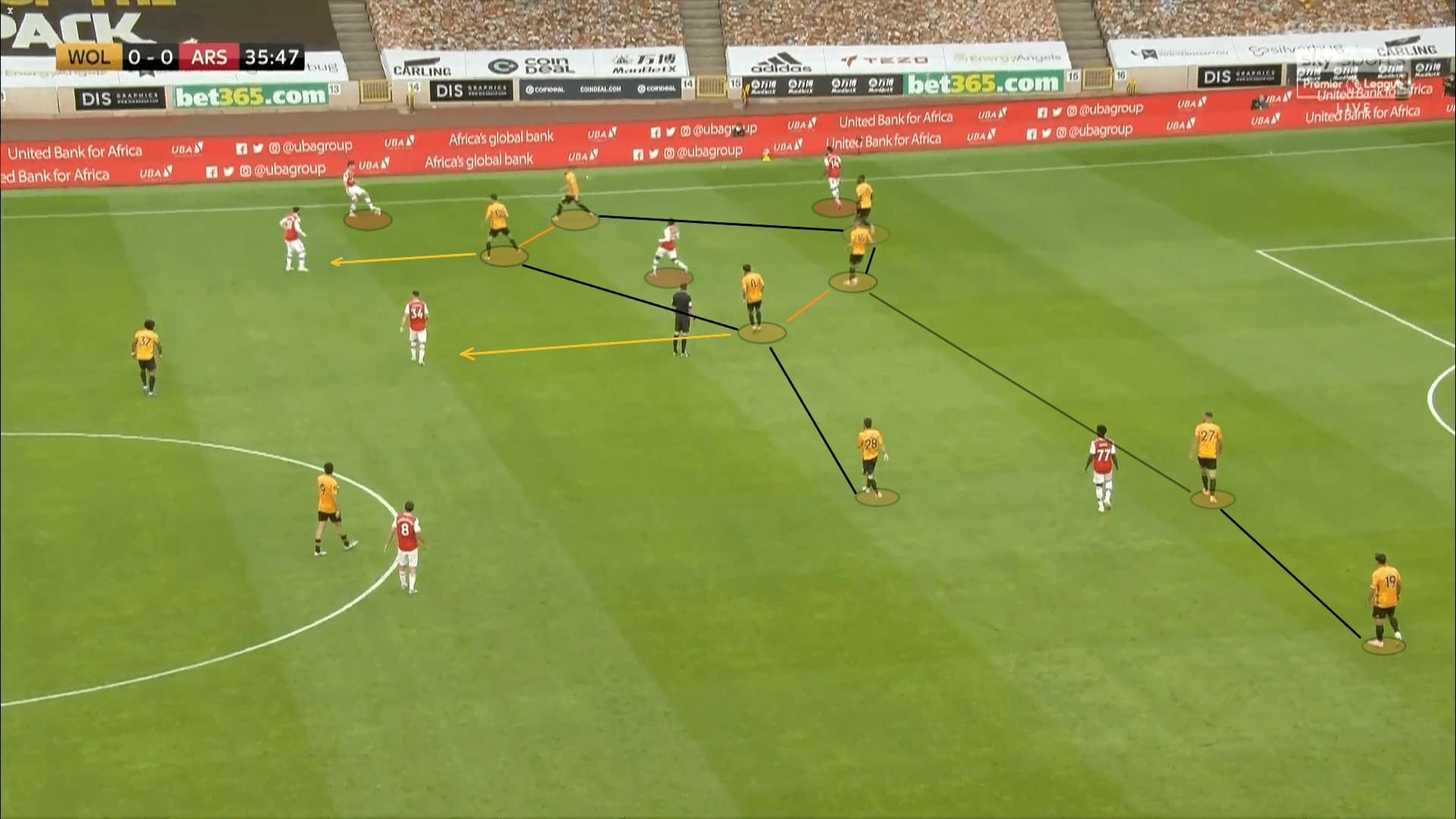
The 3-5-2 shape also allowed Wolves to press with a free midfielder while keeping the backline deeper. It was a variation of the defence and a benefit to playing with three midfielders against two.
Here, Moutinho stepped away to approach a wide receiver but Wolves were not letting the Arsenal midfield duo free. Neves and Leander Dendoncker were keeping an accessible distance with Dani Ceballos and Granit Xhaka, prevented Arsenal to build-up through the pivots. This either forced Arsenal to recirculate the ball or playing to the flanks, then, things happened as we explained in the above analysis.
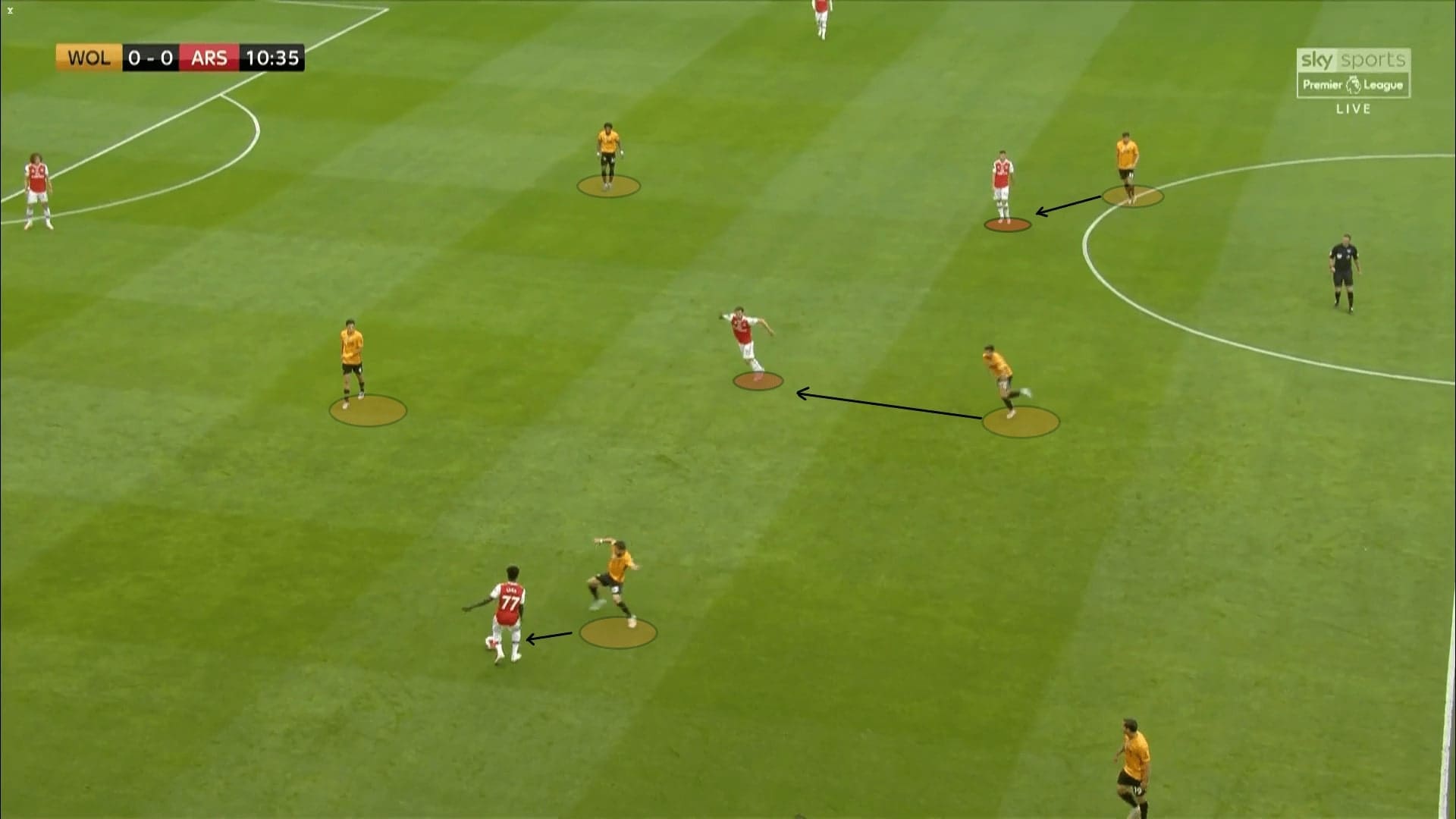
Arsenal: build-up inefficacy
Arteta’s Arsenal were trying to play out from the back, however, the build-up plays were suboptimal. There were several issues in this phase, including the failure to control the rhythm, tempo, and flow, having weak interconnectedness of players, and missing progressive ground options in the opposition half. Considering Wolves were defending with clear principles and disciplines as mentioned, Arsenal seldom created clear-cut opportunities in the positional plays.
The build-up shape was flexible as the players roamed their positions. It was roughly a 3-2 shape as the pivots often created the second layer. The wing-backs were pushed to a high and advanced position. These kept the Wolves block away from the first line and generated more room for the first line to pass.
Although we illustrated the general setup below, there were variations when the ball was moved to either side. The wide centre-backs could move wide to the half-spaces or even in the outer zone, operating as a false full-back.
Since Wolves had contained the Arsenal midfield duo, Luiz seldom played the ball centrally. Mustafi and Kolašinac were playing the out-balls more often.
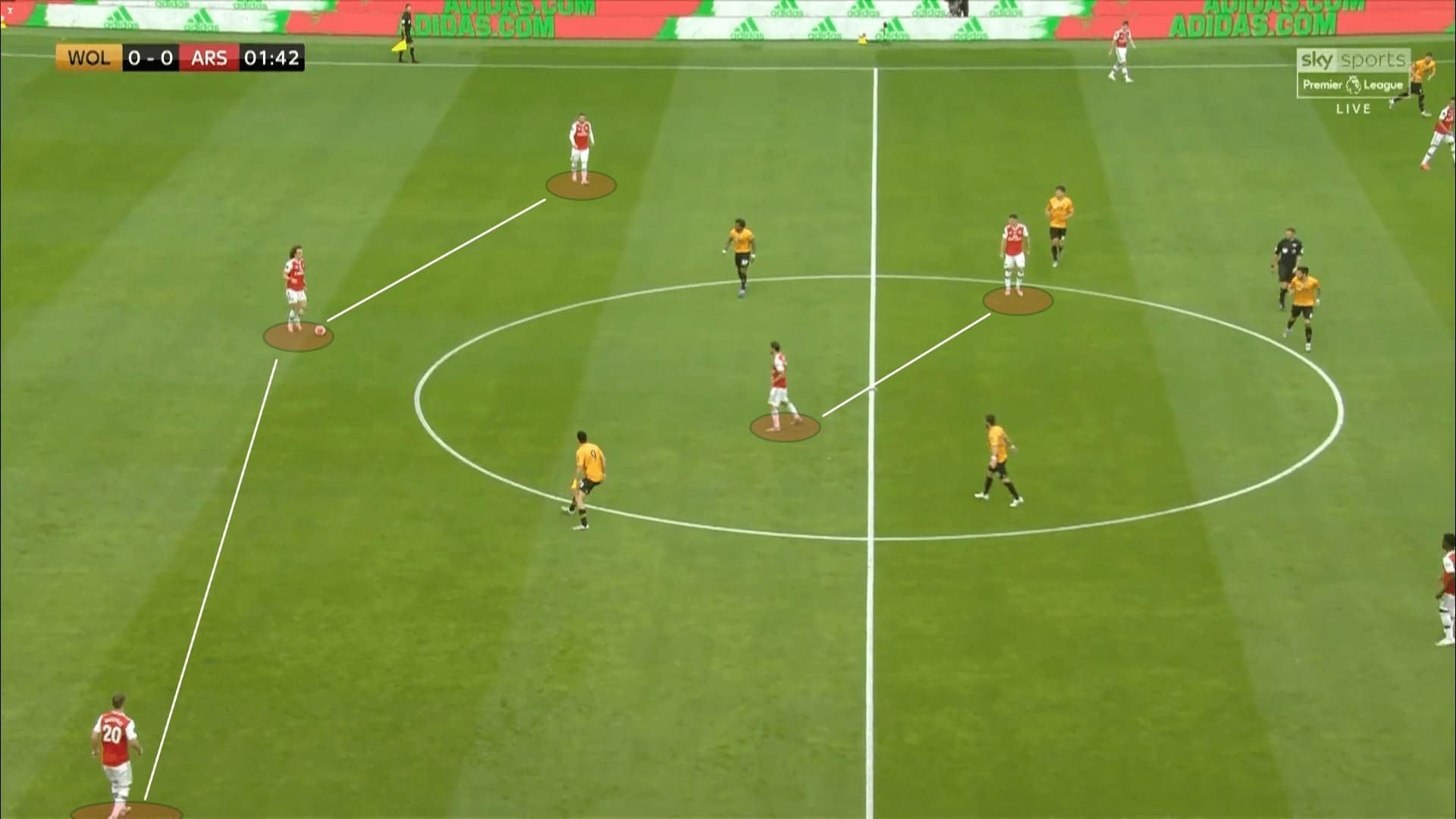
However, the wide centre-backs failed to connect with the attacking players even staying at the advantageous half-spaces. Firstly, the man-marking of Wolves’ backline constrained the progressive options, as an example, Saka and Soares were controlled by Jonny Otto and Romain Saïss, respectively. Even when they received a vertical pass, the closed body orientations and pressure from behind would only force a back pass.
As the pivots, neither Ceballos nor Xhaka were moving constantly to make themselves available. These two were staying deeper as a barrier to suffocate potential counter-attacks in the transitions. Also, Wolves were excellent in shifting – when the midfielders retreated, the ball-side striker was going to mark the pivot. Here, Ceballos was marked by Jiménez and Arsenal would not progress through the Spaniard.
Facing the pressure from Moutinho potentially, Mustafi often tried to play a long pass that attempted to open space behind the defence. However, the executions were often poor while the space between the backline and the goal was controlled by Coady. Such as in this example, where Arsenal could barely access the penalty box with these patterns.
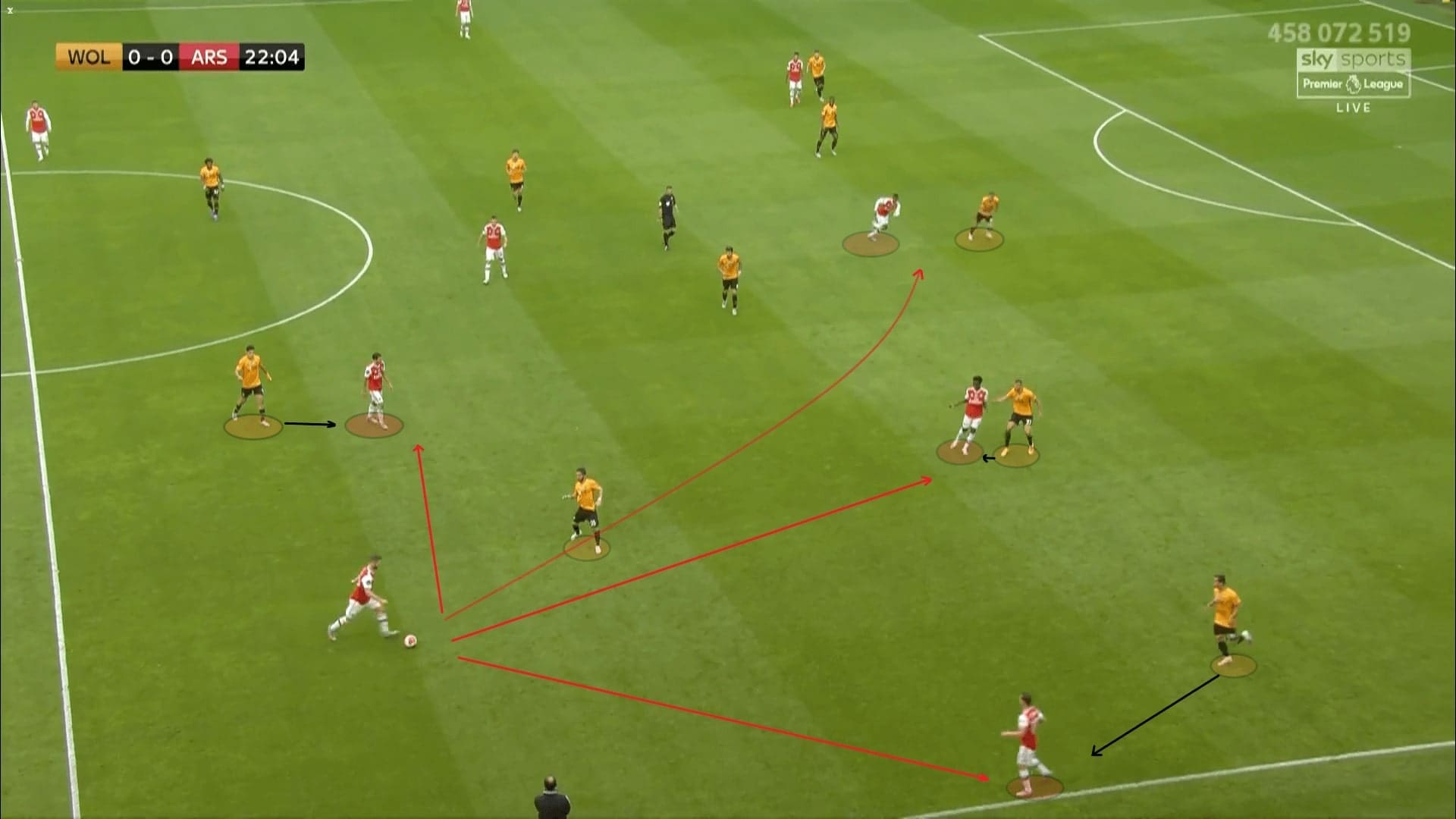
The situations were very similar on the opposite flank, although Kolašinac seemed to have a better attacking ability. Here, the same elements appeared: the progressive players Tierney and Aubameyang were marked by Boly and Matt Doherty. Meanwhile, Traoré was close to Xhaka as Neves retreated.
Again, facing the pressure from Wolves’ wide midfielder Dendoncker, Kolašinac failed to progress as no clear player was an option. The Bosnian defender was more connected to find Tierney, who operated as a left-winger in this phase, but progression was impossible. The former Celtic player did not have the skills and agility to escape from his marker while Aubameyang was not providing the supportive runs in the final third.
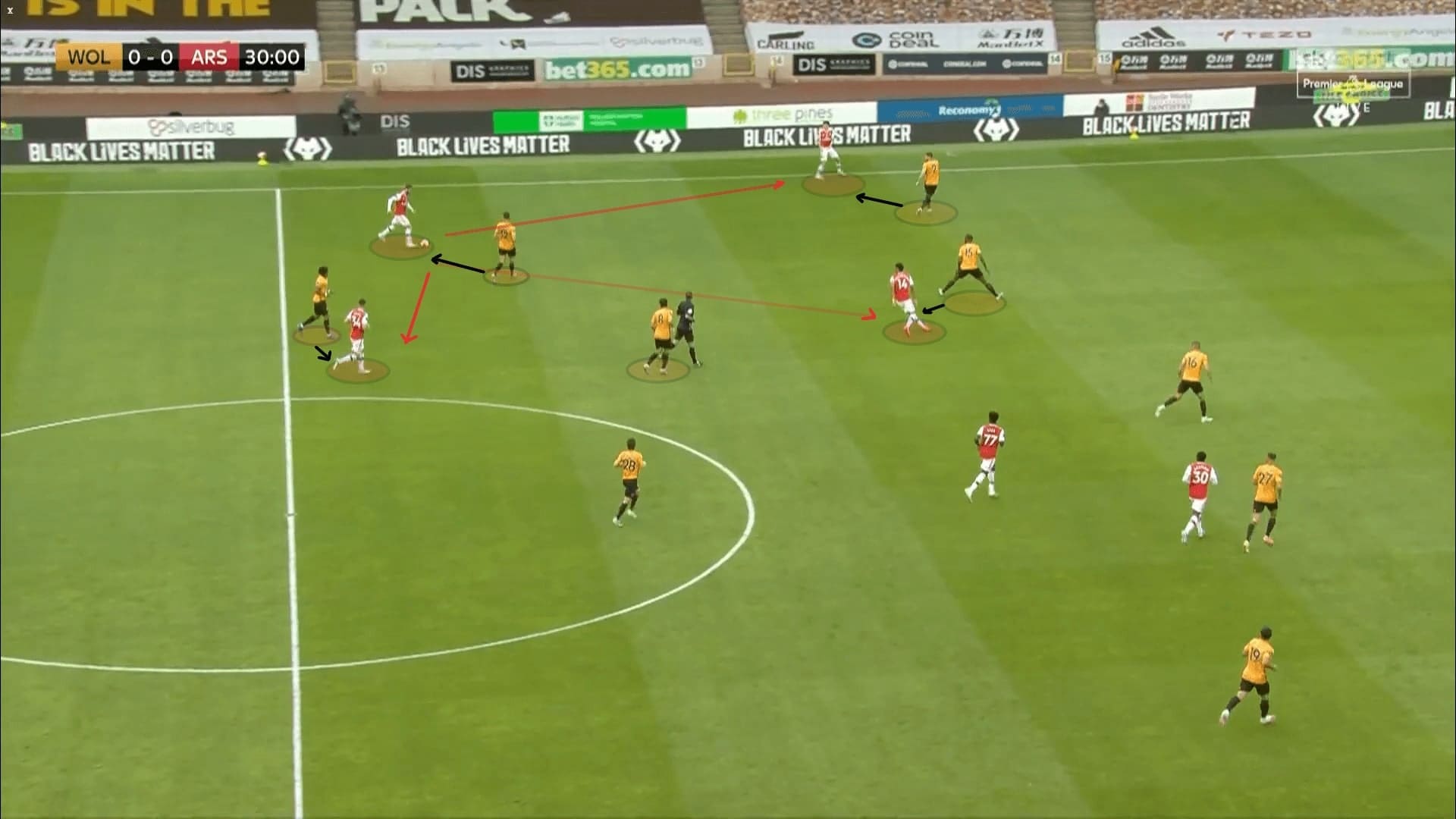
Conservative defensive scheme of Arsenal?
Although Arsenal should be the better team traditionally, their defensive scheme was rather conservative, though that was a wise move by Arteta. The pressing Wolves might have been frustrated as Nuno’s team were not playing out from the back, instead, Coady’s diagonal passes could bypass lines and reach the offensive players. If that happened, the Gunners would suffer when the likes of Traoré and Jiménez attacked exposed backline.
With a back five, Arsenal were defending in a 5-2-3, keeping Soares and Tierney with the centre-backs. On some rare occasions, the first line would pressure the backline when a 3 v 3 was achieved like in this example. The main purpose was to force a pass with lower quality because of the limited time.
Here, Nketiah pressed wisely with a curved run, which forced Coady to the Arsenal left flank. This bought time for the left wing-back and the left centre-back to read the pass and prepare for a duel.
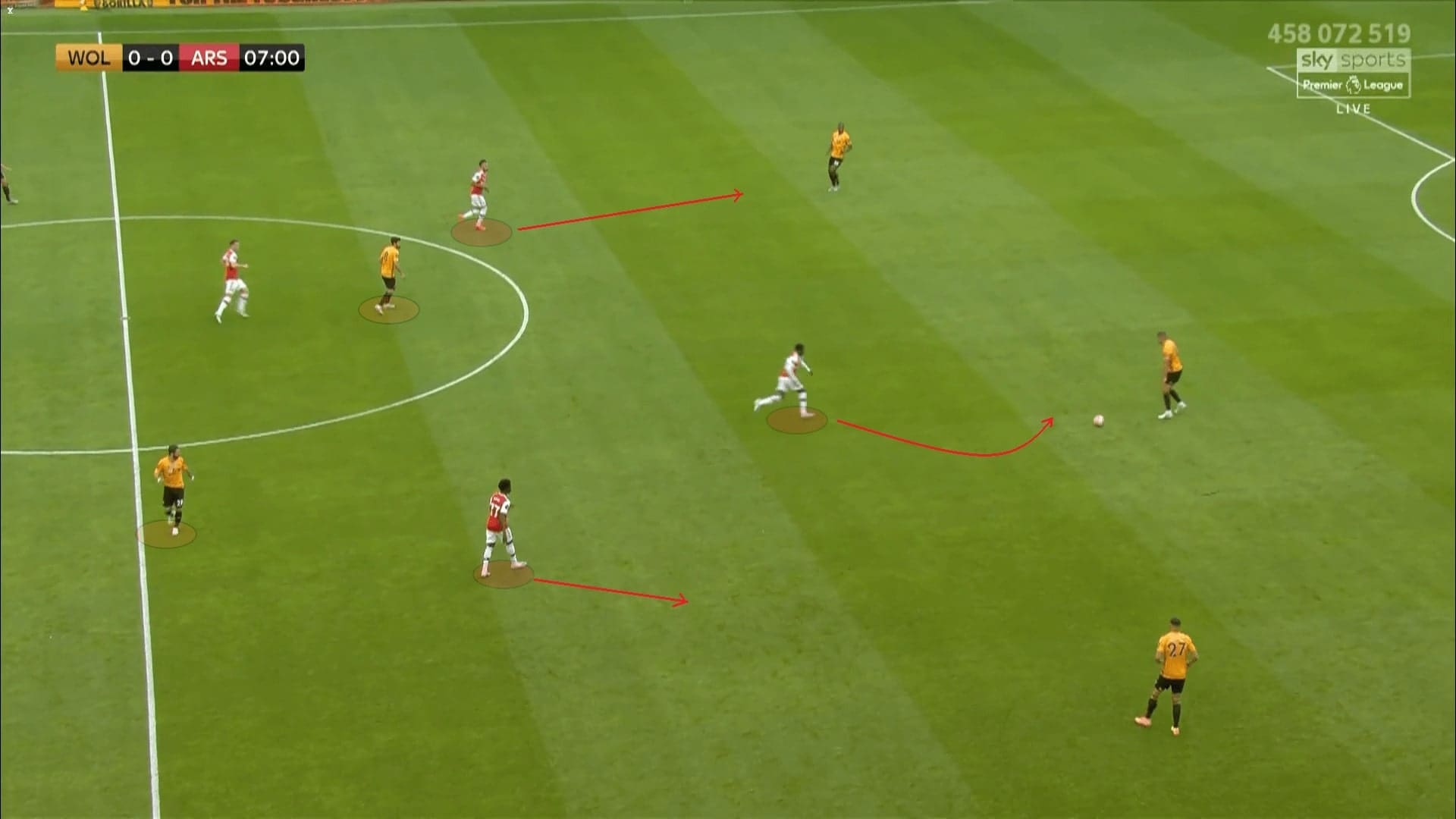
Intriguingly, although there were only two central midfielders, their positionings were not a decisive factor in the game. Here, Ceballos and Xhaka were separated and usually the attacking team would exploit the gaps between a duo. However, progressing vertically through the midfielders at the centre was not the style of Wolves.
The Arsenal wing-backs seldom came out because of the opposition midfielders. They were focused on the corresponding wing-backs so approaching Moutinho was the task of Saka below.
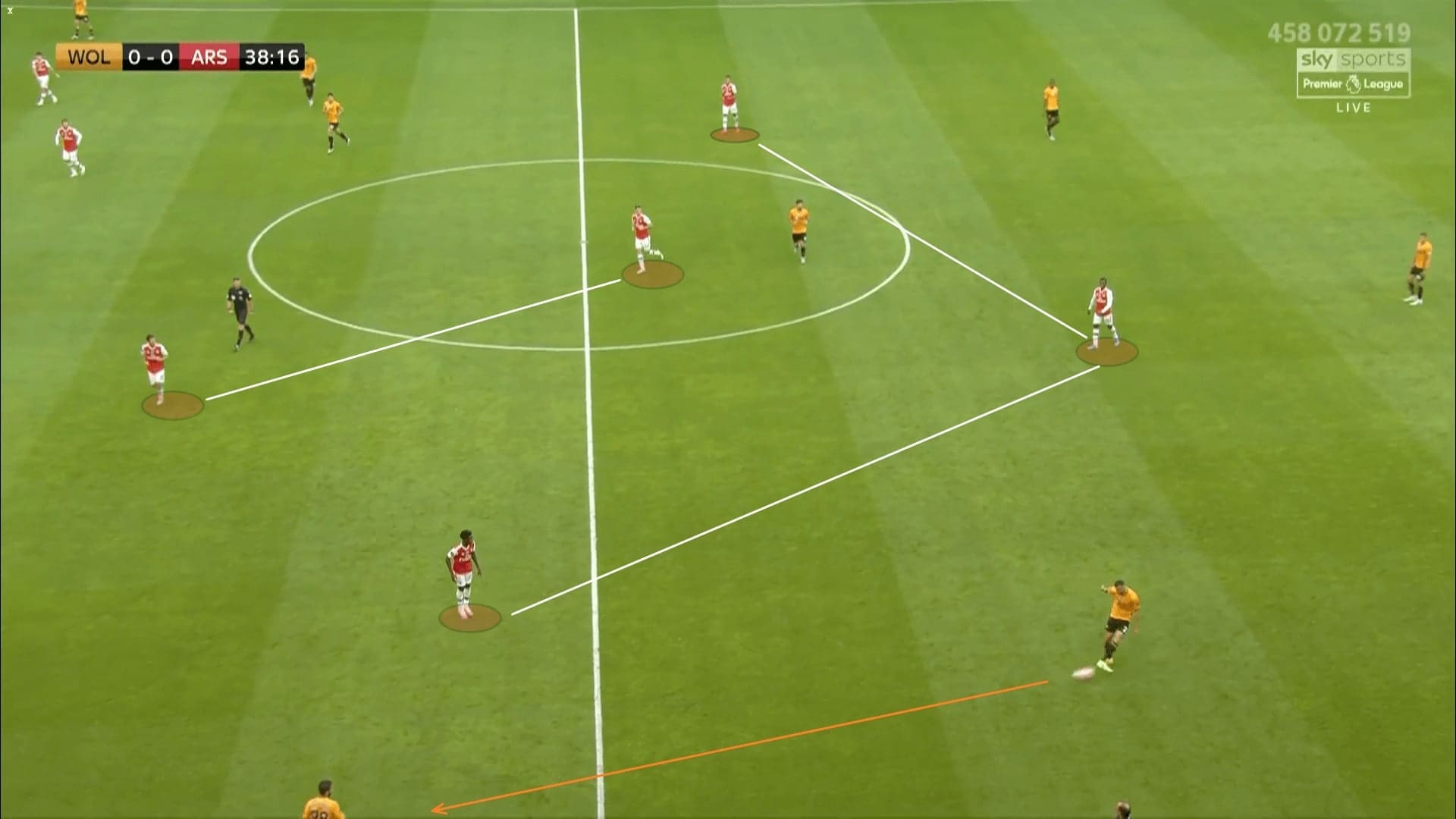
We demonstrated the way Arsenal pressed at the flanks. The structural advantage of a back five was utilised: the wide defenders were stepping out aggressively to press. Position to position, Tierney was the man taking care of Doherty while Kolašinac was always keen to leave his position.
In the below scene, Kolašinac was slightly high to follow Dendoncker as he understood Luiz would provide the defensive cover. The continuous pressure at this flank limited the threat of the wide attacks of Wolves quite well, despite space behind the Bosnian being exploited at times.
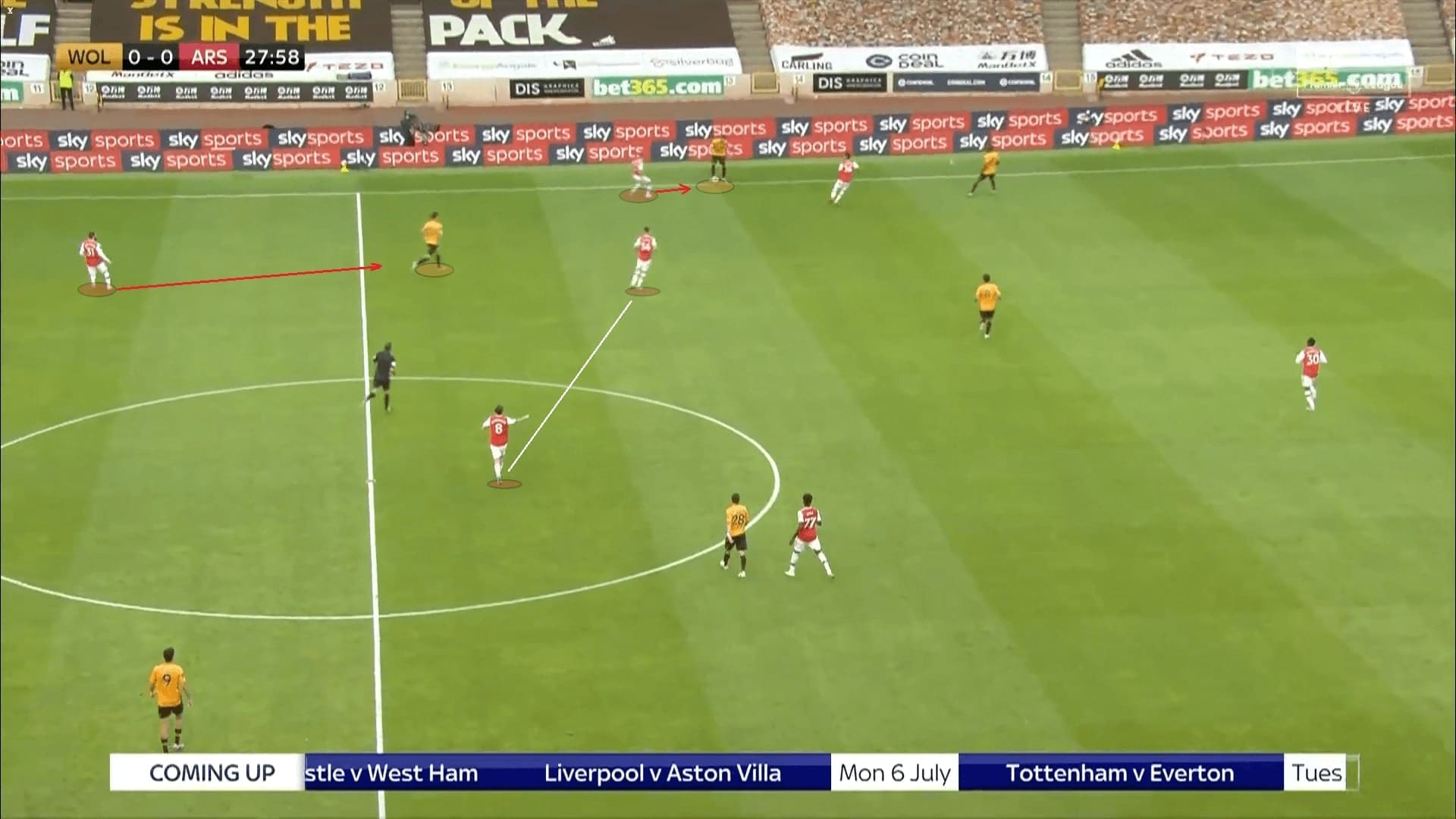
Another reason that we described Arsenal’s defensive approach in this game as passive was due to the defensive behaviours. The backline tended to retreat when the ball was brought forward by a player. The midfielders’ deep positionings allowed the accessible distances to reach the progressor, hence why they were the key to dispossess the player.
In this example, with Diogo Jota carrying the ball and supported by Jiménez and Traoré, all Arsenal centre-backs retreated instead of going in for a challenge. This was conservative but helped avoid the defence being exposed, as the likes of Jota, Pedro Neto, and Traoré were strong dribblers. Challenging recklessly might mean being dribbled past and they could only count on Emiliano Martinez.
In other words, the defensive principle of delaying was applied here. The backline needed not to challenge, and instead, they just delayed the opponent from reaching the penalty box. The midfielders would track back and defend from behind.
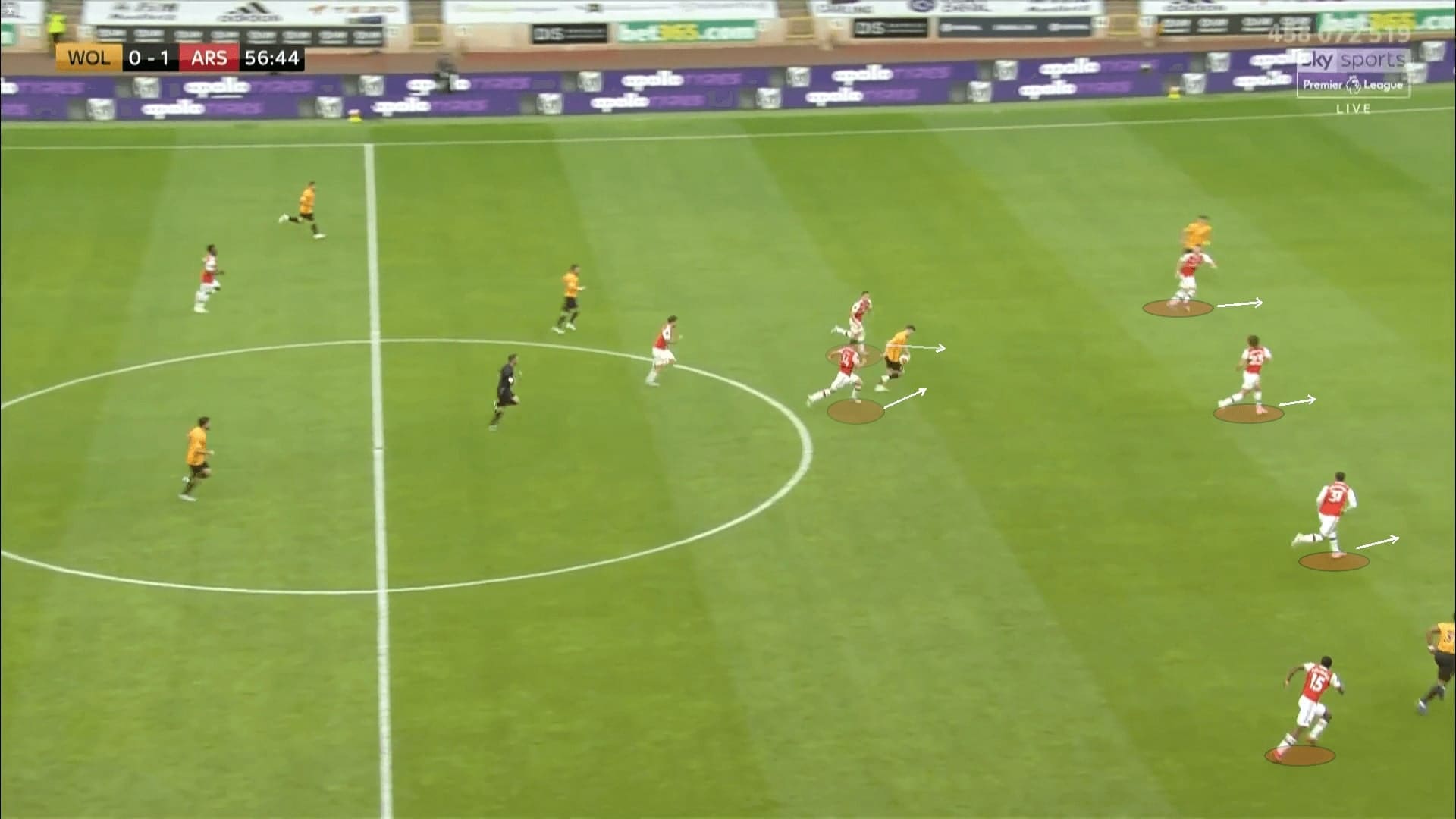
Arsenal also prepared to contain Traoré as they lowered his dribble success rate from the season average of 69% to 50% in this clash. Apart from the aggressive challenges and pressure before the Spaniard received the ball, using two left-backs was also a tactic of Arteta.
They tried to cage Traoré with multiple players, committing Kolašinac as a defensive cover of Tierney and instructed Aubameyang to defend deep. This compressed spaces at zone 18 for Traoré to cross, though the Wolves #37 still got past Tierney and crossed on several occasions.
When Jota came on and released Traoré to the right-winger position, Ainsley Maitland-Niles came on as a reply minutes later. The pace and physicality of the 22-year-old might not match Traoré, but he had a better stamina level to track him.
Here, Traoré was surrounded by three players with close proximity. Even when the first challenger Maitland-Niles failed to dispossess him, Kolašinac arrived strongly and clear the ball.
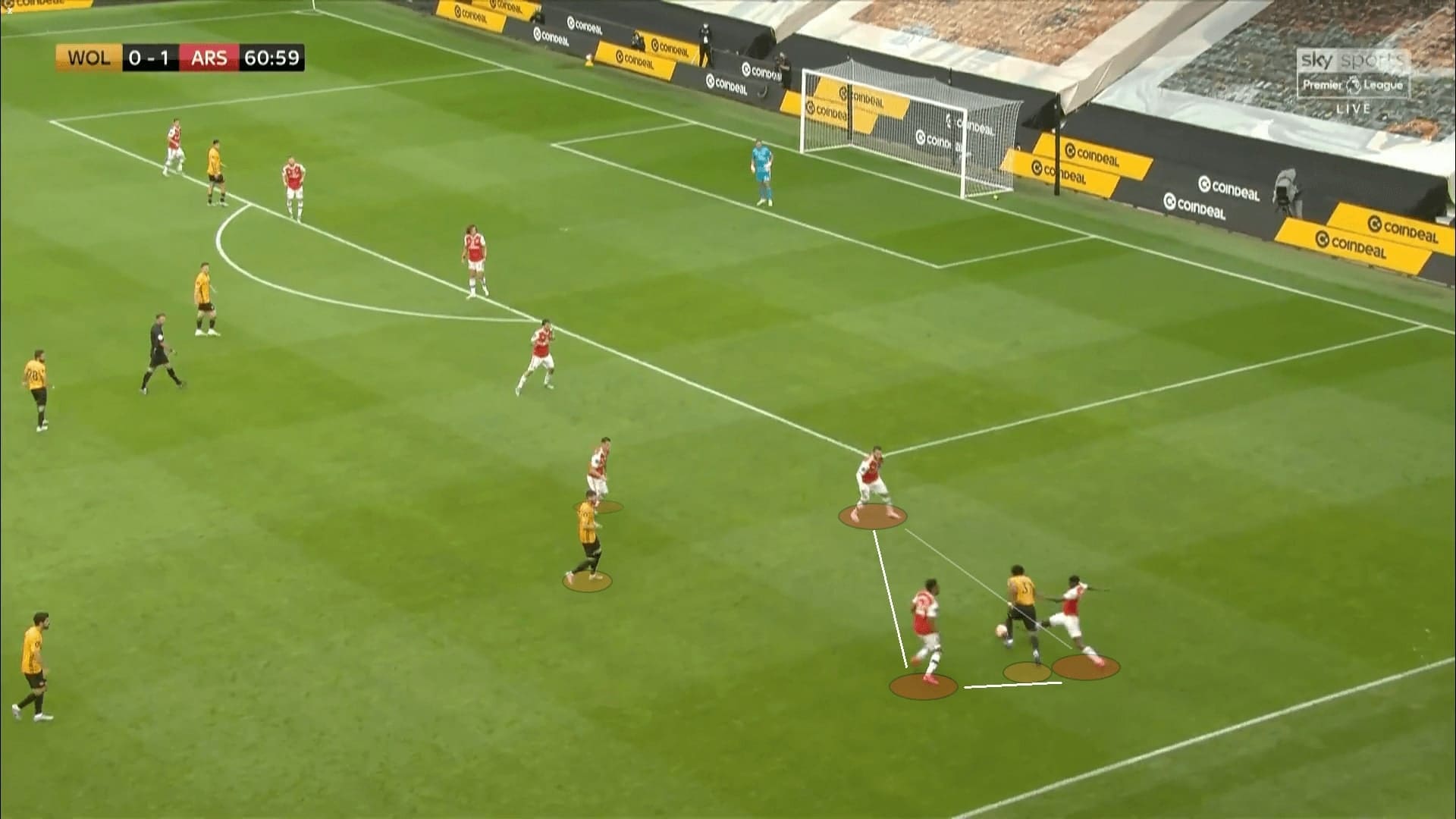
Wolves attacking the flanks
For Wolves, their offensive approach was also similar to the previous games. We mentioned playing through the pivots was not the key. Instead, Nuno’s men were more likely to bypass the first and second lines with the diagonal passes of Coady, or the long passes from Saïss.
The Wolves skipper played 13 long balls and completed 61.54%, which was quite good. In this long passing graph, we showed the directions of Coady’s long passes. As expected, most were travelling diagonally and attempted the outer right zone.
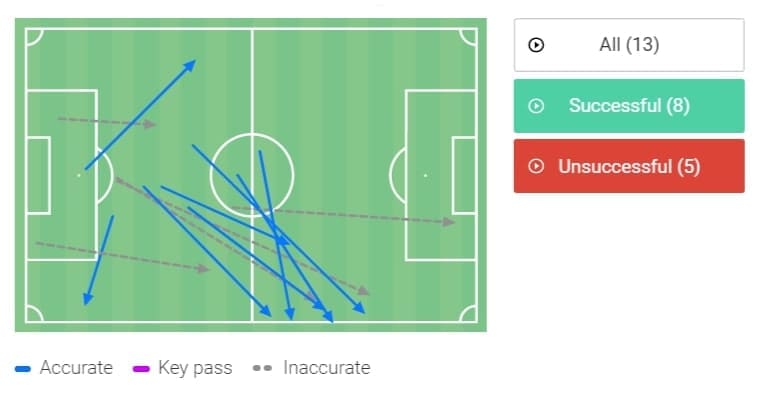
An in-game example was selected here. Wolves were having a back three and a double-pivot here, but Coady was determined to play the diagonal pass. This should travel to Doherty’s zone and directly bypassed the first two Arsenal layers.
If Wolves could control the ball from the air, Traoré, Doherty, and Jiménez were attacking the backline directly.
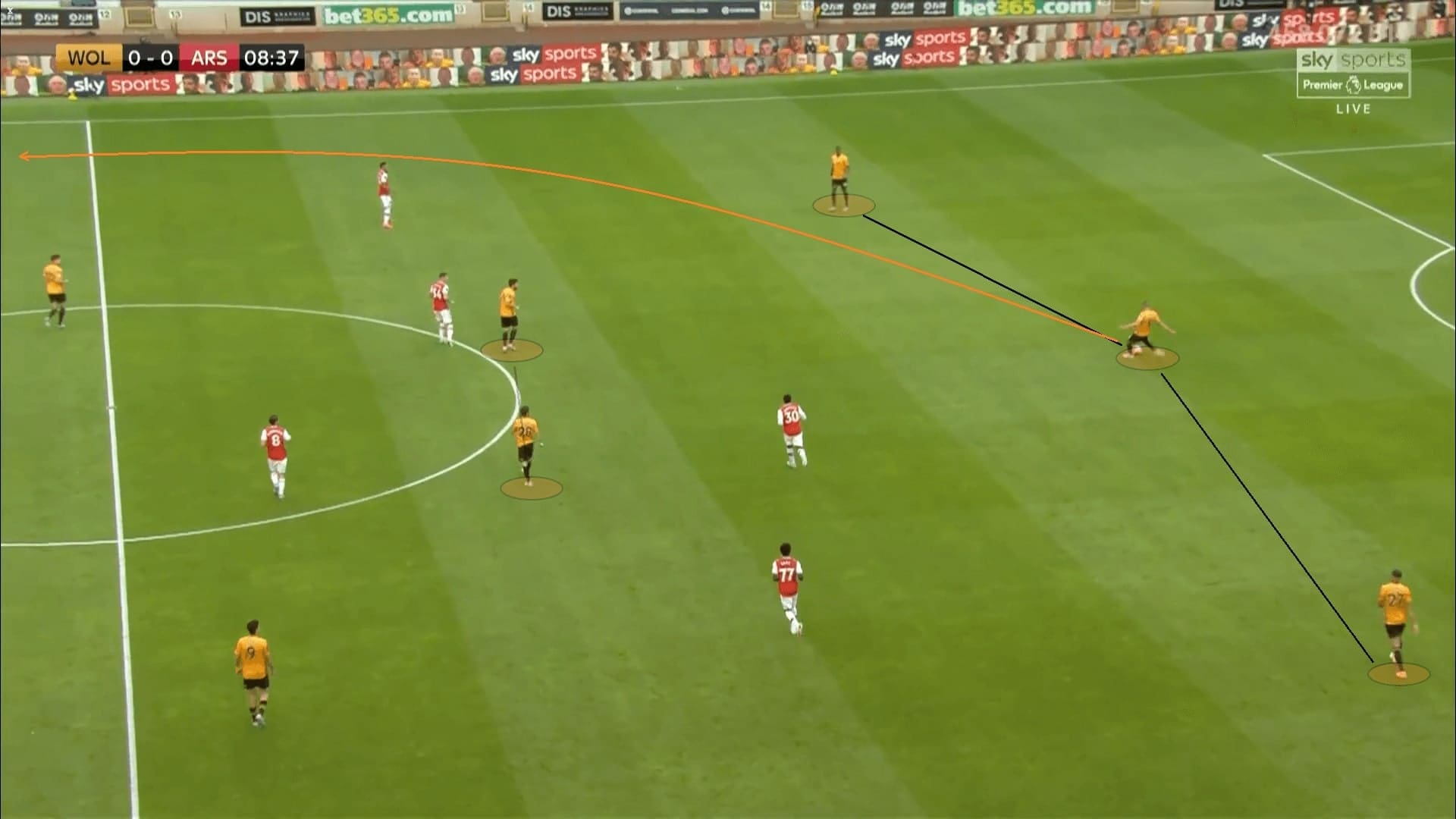
However, the physical presence in this zone hindered the development of these attacks in this game. Wolves were not as good as Arsenal in terms of offensive duels: their season average was 43.8% this year and it was only 35.59% on this night.
We framed the offensive duels at the destinations of Coady’s passes. The white squares were the unsuccessful duels and only the oranged circles were successful – the contrast is quite clear. Although several players such as Jiménez, Traoré, and Doherty were the receiver, not many attacks were developed here.
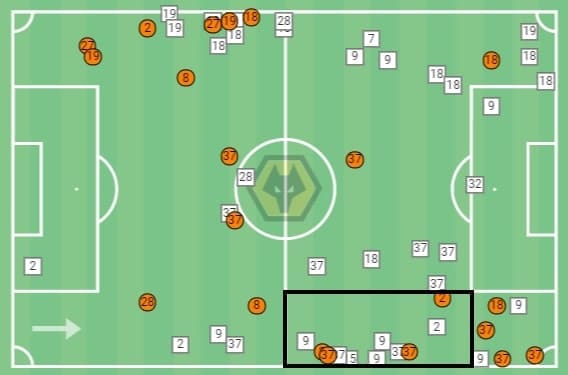
Tactical tweaks in the second half
As mentioned, Wolves were not attacking in their best form in the first half, especially when Traoré was positioned centrally and trapped by markers, constrained by tight spaces.
After the break, in the hopes of maximising the calibre of Traoré, Nuno put him on the right flank and wished to see some crosses. This was a wise move as Traoré possessed the physical superiority and qualitative superiority to take on defenders and cross.
Here, we could barely see his hair at the bottom-right corner in this image. To compensate the wide positionings of Traoré, Dendoncker was pushed further forward as another highest point of the attack. Meanwhile, Doherty could roam his position by running at the half-spaces more often.
Traoré stretched the half-spaces because of his presence at the outer zone and this opened the gap for Doherty (#2) to run into. Thanks to the mismatch created by the positional interchanges, Doherty was unmarked and Kolašinac could merely react to Dendoncker’s outward movement.
Doherty’s run was perceived by Moutinho and this was a good chance as Wolves entered the penalty area.
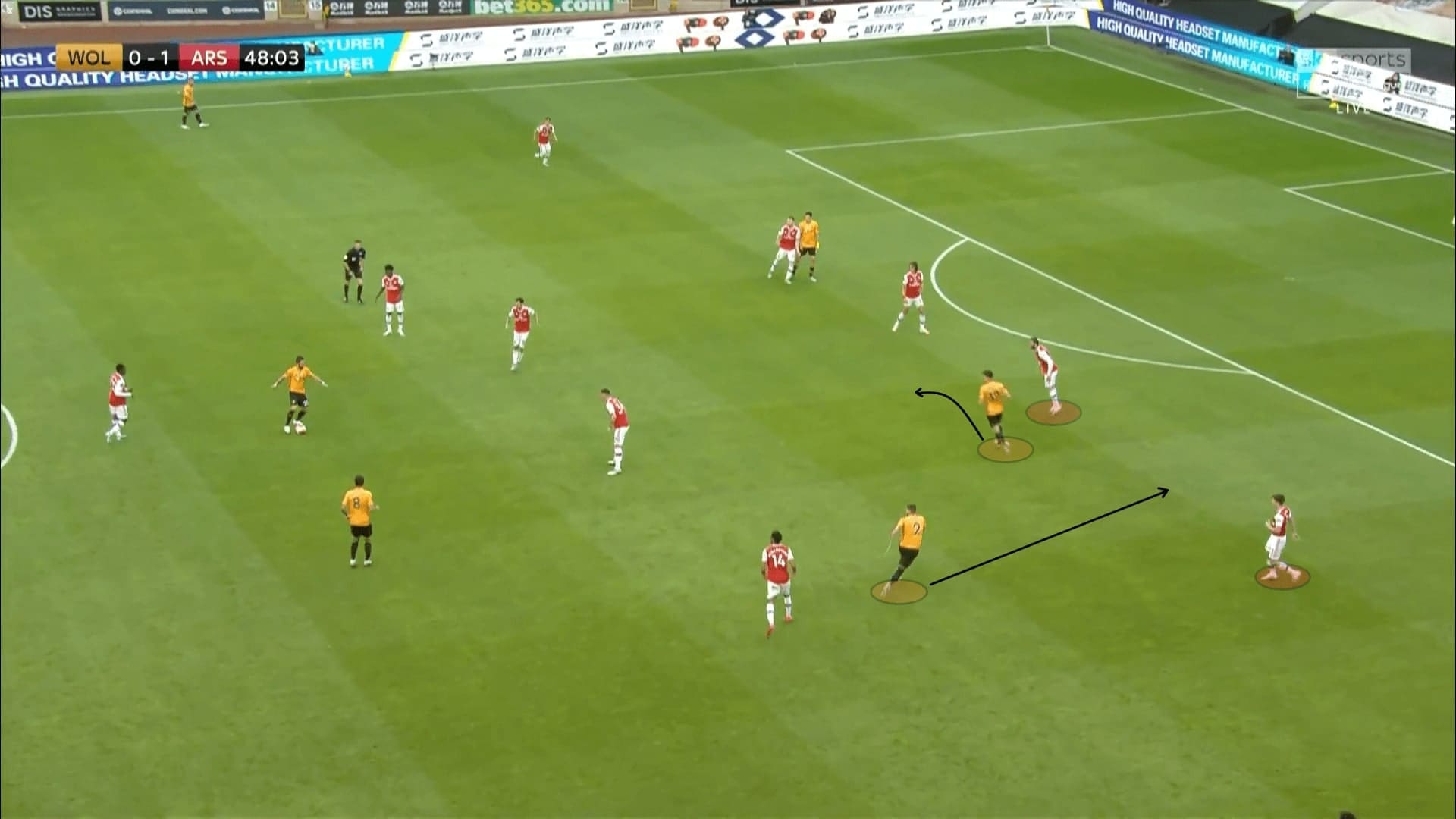
Because of the above tactics, Jota was the better personnel to execute and he came on for Dendoncker at the 55th minute.
Also, Wolves were going more directly by sending the long balls to Jiménez. The pressure was absorbed in the destination, therefore creating more space between the lines vertically. The objective was to attack spaces behind the midfielders and progress through the strong dribblers such as Jota.
The direct approach nearly created an equaliser. Wolves looked more dangerous in the transition when Kolašinac pushed high in the offensive phase. The Bosnian player was totally caught and he was unaware of the acceleration of the Spanish midfielder.
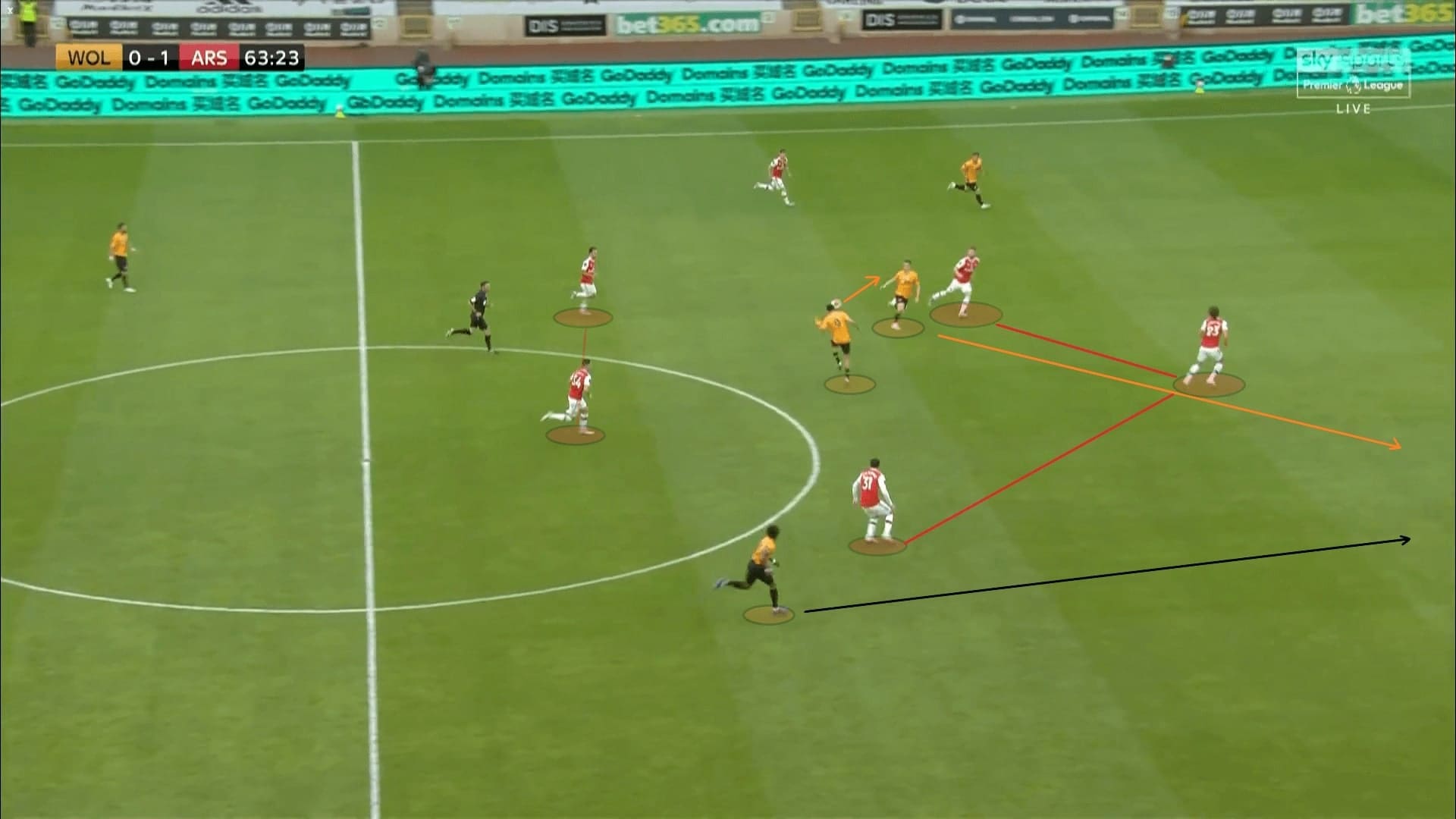
Final remarks
As well as from the open plays, the offensive set-pieces of Wolves were also below par. The deliveries on this day were not the highest standard, hence why Boly the far-post target was not found. Wolves will prepare for another important game, against Sheffield United in the midweek now.
Arsenal need to admit that luck was a part of this game. Not only was it because Arsenal scored two from a 0.96 xG, but because the Saka goal was also deflected twice and Traoré has missed a couple of chances. As Arteta said, there were good moments, but the team still have to improve in the future.




Comments